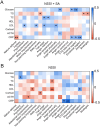Distinct correlation network of clinical characteristics in suicide attempters having adolescent major depressive disorder with non-suicidal self-injury
- PMID: 38443348
- PMCID: PMC10914800
- DOI: 10.1038/s41398-024-02843-w
Distinct correlation network of clinical characteristics in suicide attempters having adolescent major depressive disorder with non-suicidal self-injury
Abstract
Suicidal behavior and non-suicidal self-injury (NSSI) are common in adolescent patients with major depressive disorder (MDD). Thus, delineating the unique characteristics of suicide attempters having adolescent MDD with NSSI is important for suicide prediction in the clinical setting. Here, we performed psychological and biochemical assessments of 130 youths having MDD with NSSI. Participants were divided into two groups according to the presence/absence of suicide attempts (SAs). Our results demonstrated that the age of suicide attempters is lower than that of non-attempters in participants having adolescent MDD with NSSI; suicide attempters had higher Barratt Impulsiveness Scale (BIS-11) impulsivity scores and lower serum CRP and cortisol levels than those having MDD with NSSI alone, suggesting levels of cortisol and CRP were inversely correlated with SAs in patients with adolescent MDD with NSSI. Furthermore, multivariate regression analysis revealed that NSSI frequency in the last month and CRP levels were suicidal ideation predictors in adolescent MDD with NSSI, which may indicate that the increased frequency of NSSI behavior is a potential risk factor for suicide. Additionally, we explored the correlation between psychological and blood biochemical indicators to distinguish suicide attempters among participants having adolescent MDD with NSSI and identified a unique correlation network that could serve as a marker for suicide attempters. Our research data further suggested a complex correlation between the psychological and behavioral indicators of impulsivity and anger. Therefore, our study findings may provide clues to identify good clinical warning signs for SA in patients with adolescent MDD with NSSI.
© 2024. The Author(s).
Conflict of interest statement
The authors declare no competing interests.
Figures





Similar articles
-
Hypothalamic-pituitary-adrenal axis dysregulation in depressed adolescents with non-suicidal self-injury.Psychoneuroendocrinology. 2019 Apr;102:216-224. doi: 10.1016/j.psyneuen.2018.11.004. Epub 2018 Nov 14. Psychoneuroendocrinology. 2019. PMID: 30590339
-
Psychological and behavioral characteristics of suicide attempts and non-suicidal self-injury in Chinese adolescents.J Affect Disord. 2018 Jan 15;226:287-293. doi: 10.1016/j.jad.2017.10.010. Epub 2017 Oct 3. J Affect Disord. 2018. PMID: 29024902
-
Non-suicidal Self-injury Differentiates Suicide Ideators and Attempters and Predicts Future Suicide Attempts in Patients with Eating Disorders.Suicide Life Threat Behav. 2019 Oct;49(5):1220-1231. doi: 10.1111/sltb.12521. Epub 2018 Oct 24. Suicide Life Threat Behav. 2019. PMID: 30357895
-
Neural Correlates Associated With Suicide and Nonsuicidal Self-injury in Youth.Biol Psychiatry. 2021 Jan 15;89(2):119-133. doi: 10.1016/j.biopsych.2020.06.002. Epub 2020 Jun 10. Biol Psychiatry. 2021. PMID: 32782140 Free PMC article. Review.
-
Correlates of suicide attempts among self-injurers: a meta-analysis.Clin Psychol Rev. 2014 Jun;34(4):282-97. doi: 10.1016/j.cpr.2014.03.005. Epub 2014 Apr 2. Clin Psychol Rev. 2014. PMID: 24742496
Cited by
-
Association between serum oxidative stress indicators, inflammatory indicators and suicide attempts in adolescents with major depressive disorder.Front Psychiatry. 2025 Feb 24;16:1539158. doi: 10.3389/fpsyt.2025.1539158. eCollection 2025. Front Psychiatry. 2025. PMID: 40066132 Free PMC article.
-
Profiles of caregiver burden among adolescents with non-suicidal self-injury: a latent profile analysis.Front Psychiatry. 2025 May 19;16:1581640. doi: 10.3389/fpsyt.2025.1581640. eCollection 2025. Front Psychiatry. 2025. PMID: 40458782 Free PMC article.
-
A Study of Spontaneous Self-Injurious Behavior and Neuroimaging in Rhesus Macaques.Research (Wash D C). 2025 Jul 31;8:0782. doi: 10.34133/research.0782. eCollection 2025. Research (Wash D C). 2025. PMID: 40746822 Free PMC article.
-
The possible effect of inflammation on non-suicidal self-injury in adolescents with depression: a mediator of connectivity within corticostriatal reward circuitry.Eur Child Adolesc Psychiatry. 2025 Apr 5. doi: 10.1007/s00787-025-02709-6. Online ahead of print. Eur Child Adolesc Psychiatry. 2025. PMID: 40186642
-
Cortisol levels and depression suicide risk: a combined exploration of meta-analysis and case-control study.Front Psychiatry. 2025 Apr 30;16:1563819. doi: 10.3389/fpsyt.2025.1563819. eCollection 2025. Front Psychiatry. 2025. PMID: 40370593 Free PMC article.
References
-
- Seemuller F, Riedel M, Obermeier M, Bauer M, Adli M, Mundt C, et al. The controversial link between antidepressants and suicidality risks in adults: data from a naturalistic study on a large sample of in-patients with a major depressive episode. Int J Neuropsychopharmacol. 2009;12:181–9. doi: 10.1017/S1461145708009139. - DOI - PubMed
MeSH terms
Substances
Grants and funding
LinkOut - more resources
Full Text Sources
Medical
Research Materials
Miscellaneous

